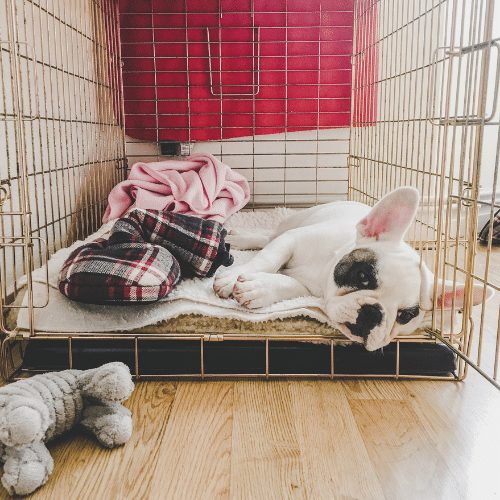Can I crate my dog for 12 hours?
April 1, 2021 2021-09-02 7:23Did you decide on crate training your new puppy or adult dog? Using a crate can make potty training easier, give your dog a safe and secure place to stay while unsupervised and can also be a great way to transport your dog in the car.
But what is the maximum amount of time you should leave your dog in a crate? Is it ok to crate him for 12 hours?
The quick answer is that while a dog can sleep through the night in his crate, he should definitely not be crated for 12 hours during the day. This is way too much time spent in isolation. Dogs are social animals that need interaction, activities, enrichment and engagement with their owners (and sometimes other dogs) in order to thrive.
Let’s look in detail at the maximum amount of time your dog should spend in a crate and what alternatives there are to crating for long periods of time.
Table of Contents

Can I crate my dog for 12 hours overnight?
In some cases you may be able to crate a dog for 10-12 hours overnight. Adult and senior dogs tend to sleep rather long at night and will be able to hold their bladder for that long. Especially more laid-back breed such as Pugs or Saint Bernards might not even want to get up before sleeping that long!
If your adult dog has slept in a crate in the past, he is likely comfortable with it already and has no problems extending his nighttime sleep by an hour or two. Of course, if you notice that he is whining, being restless or scratching the door, you should take him outside to check if he needs to empty his bladder.
Most puppies will however not be able to stay in a crate for that long without going out to potty in between. Especially very young puppies at 2-3 months old will probably have an accident if you try to crate them for 12 hours. You should plan on taking your puppy out during the night to make sure he does not get into the habit of peeing in his kennel.

Can a dog hold his bladder for 12 hours?
Many adult dogs can hold their bladder for 12 hours during the night. Similarly to humans, certain hormones prevent the dogs from needing to go pee at night with the same frequency as during the day.
Many humans would be hard-pressed to not use a bathroom for 10 hours during the day, but at night it is no problem. The same applies to dogs – they often can hold their bladder for 12 hours if they are sleeping.
During the day however, your dog will need to go potty every few hours. While some dogs can try to hold their bladder in new or exciting places, not going pee for too long can actually result in UTIs in dogs and should be discouraged.
You should never make your dog hold his bladder for 12 hours during the day – this is not healthy and will become harmful.
Is it cruel to crate a dog while at work?
Whether crating a dog while you are at work will depend on how long you are gone as well as your dog’s overall temperament and disposition.
If you have a part time job and are at work for 4 hours, it is ok to crate your dog during this time. Especially if you have taken him for a walk beforehand and done some training, he will likely just snooze until you’re back.
On the other hand, if you have a fulltime job (and possible commute time on top of that), you should not crate your dog for 8-12 hours while you are gone. This is way too long for him to be restricted to such a small space. He will likely get very bored, try to break out and develop nervous habits like incessant barking or even behavioral issues such as separation anxiety.
Dogs are social animals that require a lot of daily enrichment in order to be happy and well-behaved.
Dogs need to:
- Get physical exercise such as going on walks, playing fetch or doing dog agility
- Have mental stimulation such as through food puzzles, learning tricks or doing nosework
- Experience social interaction with their owners (and, if they are not reactive, other dogs)
- Interact with the world around them – through sniffing, exploring, walking on different surfaces, using their body in different ways
- Be trained by their owners in order to work on important skills such as leah-walking or sitting and coming when called
A dog that sits in a crate for 12 hours a day cannot experience any of these. It is not fair to a dog to be crated for that long during the day.
Crates for dogs of different temperaments
You need to consider your dog’s age, character and breed-specific tendencies when it comes to how long he should stay in a crate. A senior Greyhound is likely going to be very happy to snooze away a long afternoon in a comfortable crate. An elderly Newfoundland probably will enjoy to sleep in a cool crate inside when it is hot outdoors during the summer.
On the other hand, an adolescent Husky could be bored out of his mind if you want him to take a 6 hour nap in the crate in the middle of the day. A high-strung young Doodle can become frustrated an d develop poor manners if he has to stay in a crate for 7 hours while you are at work.
As always, do not acquire a dog whose exercise and training needs do not match your lifestyle. It is unfair to buy a high-energy dog and put him in a kennel for many hours every day.

Alternatives to having your dog stay in a kennel
Many owners struggle to find alternatives to having their dog stay in a crate. If your dog likes to chew and scratch, keeping him in an indestructible dog crate may be the only way they have to keep him from destroying their home.
Here are some alternatives to keeping your dog in a crate for long hours during the day:
Doggy daycare
If your dog is friendly with other dogs, going to doggy daycare is a great alternative to staying in a crate at home. At daycare, he can socialize with other dogs, get to be around new people and return home tired at the end of the day. Many daycare centers also offer the opportunity to have your dog trained during the day which can be an added bonus for busy owners.

Dog walkers
If your dog is not friendly with other dogs and doggy daycare is not an option, a dogwalker can let him out of the kennel in the middle of the day and give him some much needed exercise and activity.
Having a trusted dogwalker will not only come in handy while you are at work however: If you want to go on a vacation or go on a weekend getaway, having a dogwalker who already knows and understands your dog is invaluable. If you cannot afford to have a dogwalker take your dog out every day, even once or twice a week will make a big difference to his overall wellbeing and happiness!
Dog-proof rooms
Dogs often get crates during the day because they are highly destructive. Of course, you do not want to let your dog have the run of the house for 8-12 hours and come home to a nightmare.
A good alternative to kenneling is to create a dog-proof room. Laundry rooms or mud rooms are great for that. Use easy-to-clean flooring such as laminate and add some indestructible rubber toys. Your dog will feel much better if he can move around in the room, stretch his legs and play with his toys rather than being locked in a crate all day long.
Dog yards
If you have a backyard, you can also turn that into a place that is safe and enriching for your dog. Of course, make sure you have a secure fence so that your pup does not disappear.
By just adding a few features, you can make your yard very fun for your dog. How about:
- A sandpit where he can dig
- Some rubber tires or wooden structures to climb on
- A flirtpole to play with
- Toys to play with
Your dog will be much better behaved if he gets to walk around and explore in your yard during the day than if he is in a crate for long hours.
What is the maximum time you can crate a dog for?
There is no definite time limit to how long you can crate a dog for. Of course, if he has an accident in the crate, you had him in there for too long.
It is important to distinguish between occasional longer crate times and kenneling your dog for endless hours on a daily basis.
If you have a family emergency and need to leave your dog in a crate for 12 hours, he will be just fine. However, if you plan to do this as a general management every weekday as you are at work, this is too long!
The same applies for car rides. In a car your dog is safest if he rides in a crate. One or two long days of driving across the country will not be a problem. However, if you want to crate your dog for 10 hours each day while he is at home – this is not going to go well.

The Bottom Line
When it comes to the maximum time you can crate a dog for, you need to consider several factors. Make the decision based on:
- Your dog’s age and breed
- Your dog’s disposition and energy level
- Whether he will only be crated for a longer period once in a while or on an ongoing basis
In most cases, you can find great alternatives to crating a dog for long hours during the day. Dog walkers, doggy daycares, dog-proof rooms or dog yards all offer plenty of much needed stimulation and enrichment to your dog.
Crating your dog for a longer period during the night is a different story. Especially older dogs and laid-back breeds can easily sleep for 10+ hours at night without needing to get up. It is totally fine to crate your dog for that long during the night, especially if he has plenty of activities during the day.
Young puppies however won’t be able to sleep for that long right away. You should take them to the bathroom halfway through the night to prevent any potty accidents.

